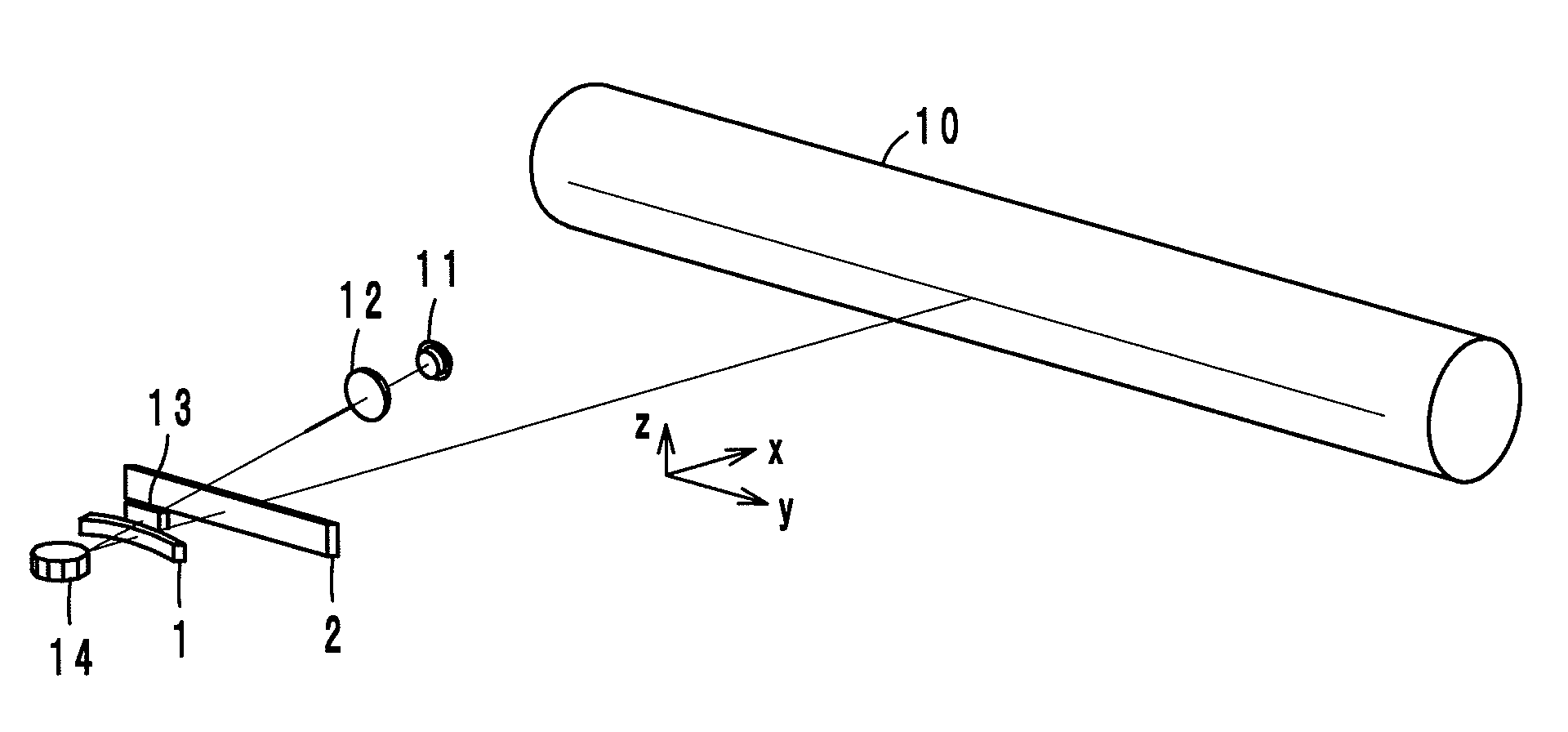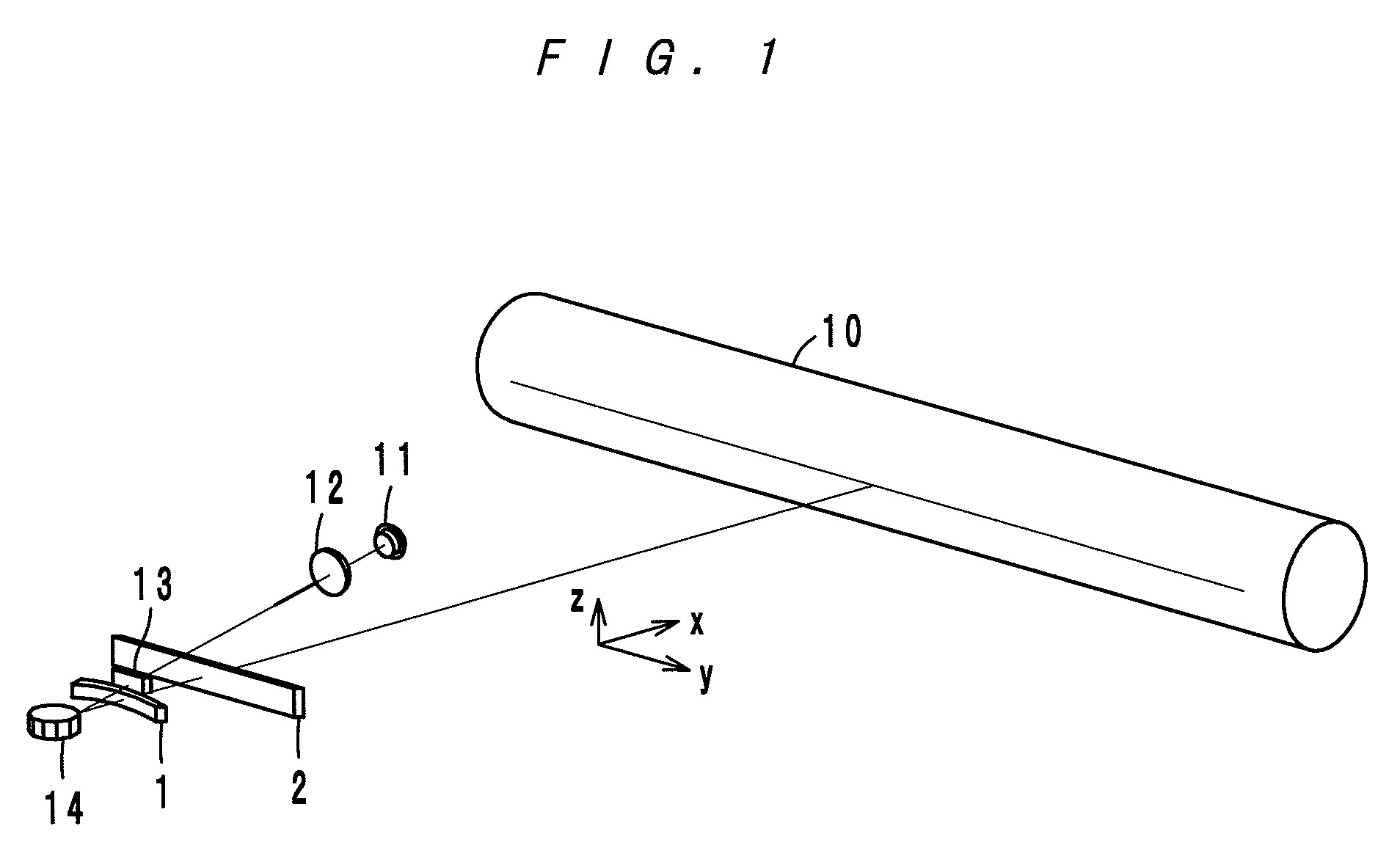Optical scanning device
a scanning device and optical technology, applied in the field of optical scanning devices, can solve the problems of insufficient correction of errors in the angle of reflection surfaces of polygon mirrors, loss of conjugate relation, and increase of sub-scanning magnification, etc., and achieve good balance
- Summary
- Abstract
- Description
- Claims
- Application Information
AI Technical Summary
Benefits of technology
Problems solved by technology
Method used
Image
Examples
first embodiment
See FIGS. 2 to 9
[0037]An optical scanning device according to a first embodiment, as shown in FIG. 2A to FIG. 2D, comprises a laser diode 11, a collimator lens 12, a free-form-surface lens 13, a polygon mirror 14 and scanning lenses 1 and 2. A light beam B1 incident to the reflecting surfaces of the polygon mirror 14 is wider in the main-scanning direction y than a single reflecting surface 14a of the polygon mirror 14 (see FIG. 3A and FIG. 3B), and the width of a light beam used for image writing is regulated by the reflecting surface 14a. In FIG. 2A to FIG. 2D, it is drawn that the light beam B1 in an upstream side has the same width as that after the regulation. As is apparent from comparison of FIG. 2A and FIG. 2B, the portion of the free-form-surface lens 13 through which a light beam B2 used for image writing passes changes as a deflection angle changes.
[0038]FIG. 3A and FIG. 3B show the light beam B2 reflected on the polygon mirror 14, and a light beam B3 that is not used for...
second embodiment
See FIGS. 10 to FIG. 14
[0062]As shown in FIG. 10, an optical scanning according to a second embodiment is basically of a similar structure to that of the first embodiment. The optical scanning device according to the second embodiment generally comprises a laser diode 11 as a light source, a collimator lens 12, a free-form-surface lens 13, a polygon mirror 14 having a plurality of flat reflecting surfaces, and scanning lenses 1 and 2. The second embodiment is different from the first embodiment in that the scanning lenses 1 and 2 are disposed slightly farther from the polygon mirror 14. Further, effects of the second embodiment are basically the same as those of the first embodiment.
[0063]Table 4, Table 5, and Table 6 below show construction data that numerically represents the second embodiment. Although the positional relation among the optical elements in the second embodiment is different from that in the first embodiment, the types of the surfaces, the positioning order of the ...
third embodiment
See FIGS. 15 to 19
[0069]As shown in FIG. 15, an optical scanning according to a third embodiment is basically of a similar structure to that of the first embodiment. The optical scanning device according to the third embodiment generally comprises a laser diode 11 as a light source, a collimator lens 12, a free-form-surface lens 13, a polygon mirror 14 having a plurality of flat reflecting surfaces, and scanning lenses 1 and 2. The third embodiment is different from the first embodiment in that the scanning lenses 1 and 2 are disposed slightly closer to the polygon mirror 14. Further, effects of the third embodiment are basically the same as those of the first embodiment.
[0070]Table 7, Table 8, and Table 9 below show construction data that numerically represents the third embodiment. Although the positional relation among the optical elements in the third embodiment is different from that in the first embodiment, the types of the surfaces, the positioning order of the optical elemen...
PUM
 Login to View More
Login to View More Abstract
Description
Claims
Application Information
 Login to View More
Login to View More - R&D
- Intellectual Property
- Life Sciences
- Materials
- Tech Scout
- Unparalleled Data Quality
- Higher Quality Content
- 60% Fewer Hallucinations
Browse by: Latest US Patents, China's latest patents, Technical Efficacy Thesaurus, Application Domain, Technology Topic, Popular Technical Reports.
© 2025 PatSnap. All rights reserved.Legal|Privacy policy|Modern Slavery Act Transparency Statement|Sitemap|About US| Contact US: help@patsnap.com



